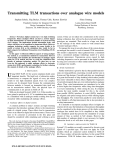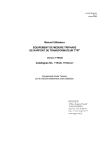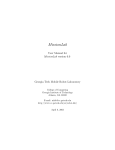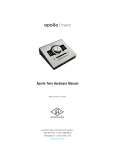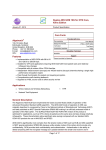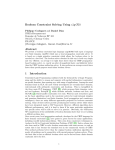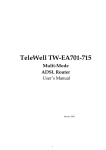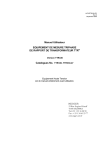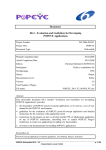Download FOSSY - Predictable SystemC(TM)/C++ Synthesis
Transcript
ate Design
eiche, am Beispiel Verkehr:
R&D Division Transportation
Hardware/Software Design Methodology Group
Predictable SystemCTM/C++ Synthesis
The Fossy Manual
Folie 25
OFFIS – Institut für Informatik
Oldenburg 2009
Last compiled: July 7, 2009
Contents
1 Introduction . . . . . . . . . . . . . . . . . . . . . . . . . . . . . . . . . . . . . . . . . . . . . . . . . . . . . . . . . . . . . .
1.1 Overview . . . . . . . . . . . . . . . . . . . . . . . . . . . . . . . . . . . . .
1.2 Typographical conventions . . . . . . . . . . . . . . . . . . . . . . . . . . . .
5
5
5
2 Using Fossy . . . . . . . . . . . . . . . . . . . . . . . . . . . . . . . . . . . . . . . . . . . . . . . . . . . . . . . . . . . . . . 9
2.1 General Information . . . . . . . . . . . . . . . . . . . . . . . . . . . . . . .
9
2.2 Structure of Fossy Installation . . . . . . . . . . . . . . . . . . . . . . . . . .
9
2.3 Running Fossy . . . . . . . . . . . . . . . . . . . . . . . . . . . . . . . . . .
9
2.4 Example . . . . . . . . . . . . . . . . . . . . . . . . . . . . . . . . . . . . . . 10
3 Synthesis. . . . . . . . . . . . . . . . . . . . . . . . . . . . . . . . . . . . . . . . . . . . . . . . . . . . . . . . . . . . . . . . .
3.1 Introduction . . . . . . . . . . . . . . . . . . . . . . . . . . . . . . . . . . . .
3.2 Synthesis Subset . . . . . . . . . . . . . . . . . . . . . . . . . . . . . . . . .
3.2.1 Compatibility to the SystemC Synthesisable Subset . . . . . . . . . .
3.2.2 Coding Guidelines . . . . . . . . . . . . . . . . . . . . . . . . . . . .
3.2.3 Design Hierarchy . . . . . . . . . . . . . . . . . . . . . . . . . . . . .
3.2.4 Processes . . . . . . . . . . . . . . . . . . . . . . . . . . . . . . . . .
3.2.5 Datatypes . . . . . . . . . . . . . . . . . . . . . . . . . . . . . . . . .
3.2.6 Statements and Expressions . . . . . . . . . . . . . . . . . . . . . . .
3.2.7 Classes and Inheritance . . . . . . . . . . . . . . . . . . . . . . . . . .
3.2.8 Templates . . . . . . . . . . . . . . . . . . . . . . . . . . . . . . . . .
3.2.9 Namespaces . . . . . . . . . . . . . . . . . . . . . . . . . . . . . . . .
3.2.10 Polymorphic Objects . . . . . . . . . . . . . . . . . . . . . . . . . . .
3.2.11 Shared Objects . . . . . . . . . . . . . . . . . . . . . . . . . . . . . .
3.2.12 Non-Synthesisable . . . . . . . . . . . . . . . . . . . . . . . . . . . .
13
13
13
13
15
16
19
24
25
26
27
27
27
27
27
4 Summary and Support . . . . . . . . . . . . . . . . . . . . . . . . . . . . . . . . . . . . . . . . . . . . . . . . . . . . 29
4.1 Support . . . . . . . . . . . . . . . . . . . . . . . . . . . . . . . . . . . . . . 29
4.2 Conclusion . . . . . . . . . . . . . . . . . . . . . . . . . . . . . . . . . . . . . 29
References and Further Reading . . . . . . . . . . . . . . . . . . . . . . . . . . . . . . . . . . . . . . . . . . . . . . 29
1
Introduction
The following document serves as a quick introduction to the usage of Fossy. To understand this manual you should already be familiar with basic concepts of hardware design.
Moreover, basic knowledge of SystemC is required since Fossy is a compiler that transforms
SystemC code into synthesisable VHDL.
1.1
Overview
• Fossy stands for Functional Oldenburg System SYnthesiser.
• Fossy is a tool for transforming system-level SystemC models to synthesisable VHDL.
• Fossy enables a seamless design flow for embedded HW/SW systems.
Fossy has been developed at the OFFIS Institute for Information Technology, an application
oriented research and development institute working on system-level design methodologies
for more than ten years. Two consecutive research projects (funded by the European
Union) in cooperation with leading industrial partners resulted in robust tools with a focus
on practical applicability.
This manual is structured as follows:
• The follwing part of Chapter 1 presents the typographical conventions used throughout
this manual.
• Chapter 2 gives an overview of the Fossy command line tool.
• Chapter 3 presents the SystemC synthesis capabilities of Fossy. It start with an
general introduction followed by the definition of the supported synthesis subset.
• Chapter 4 provides contact information in case of technical questions and recommands
further readings.
1.2
Typographical conventions
This manual uses the following typographical conventions. For continuous text the
conventions shown in Table 1.1 are used. An example of a source code listing is shown in
Listing 1.1. Comments are printed in italics while C++ keywords are printed in bold font.
Special SystemC language elements are printed in blue color. To better emphasise certain
parts of the source code printed in red color.
6
1 Introduction
Convention
Times New Roman
Times New Roman
Monospace font
Monospace italics
Monospace font
Item
Normal Text
Emphasised Text
Class, function, method or
macro names
Variables meant to be replaced when the language
construct is used.
Sometimes variables or parameters are omitted.
Shell commands
Example
This is an example sentence.
This word is emphasised.
execute_operation()
my_class<parameter >
my_class<...>
do_something(...)
make
Table 1.1: Typographical conventions for continuous text
1.2 Typographical conventions
1
7
#include <systemc . h>
2
3
4
5
6
7
8
SC MODULE( my module ) {
/∗ −−−−− i n p u t p o r t s −−−−− ∗/
s c i n <bool> c l o c k ;
s c i n <bool> r e s e t ;
// add your i n p u t p o r t s h e r e
// s c i n < s c u i n t <32> > i n d a t a ;
9
10
11
12
/∗ −−−−− o u t p u t p o r t s −−−−− ∗/
// add your o u t p u t p o r t s h e r e
// s c o u t < s c u i n t <32> > o u t d a t a ;
13
14
15
16
17
18
19
/∗ −−−−− c o n s t r u c t o r −−−−− ∗/
SC CTOR( my module ) {
/∗ −−−−− p r o c e s s d e f i n i t i o n s −−−−− ∗/
SC CTHREAD( p r o c e s s i n g , c l o c k . pos ( ) ) ;
r e s e t s i g n a l i s ( r e s e t , true ) ;
}
20
21
22
23
private :
/∗ −−−−− p r o c e s s ( e s ) −−−−− ∗/
void p r o c e s s i n g ( ) ;
24
25
26
27
/∗ −−−−− sub−module ( s ) , and o t h e r members −−−−− ∗/
// . . .
} ; // my module
28
29
30
31
32
/∗ −−−−− p r o c e s s body −−−−− ∗/
void
my module : : p r o c e s s i n g ( ) {
/∗ −−−−− r e s e t b l o c k −−−−− ∗/
33
34
35
36
37
38
39
wait ( ) ;
while ( true ) {
/∗ −−−−− main l o o p −−−−− ∗/
wait ( ) ;
}
} // my module : : p r o c e s s i n g ( )
40
41
42
43
44
45
46
47
48
49
50
/∗ −−−−− sc main ( ) −−−−−
∗
∗ This i s o p t i o n a l and o n l y r e q u i r e d , i f you have more than one
∗ module i n your d e s i g n . In t h a t case , you s h o u l d i n s t a n t i a t e
∗ your top−l e v e l module h e r e .
∗/
int s c m ain ( int , char ∗ [ ] ) {
my module top ( ”top ” ) ;
return 0 ;
}
Listing 1.1: Typographical conventions for listings
Listing 1.1 shows the typographical conventions for “terminal sessions”. The > symbolises
the user prompt. Like is the source code listings the [...] means that parts of the listing
have been omitted.
8
1 Introduction
> cd my_project_folder
> fossy my_top_level_design .cc
[...]
Listing 1.2: Typographical conventions for “terminal sessions”
2
Using Fossy
2.1
General Information
For accessing and testing the synthesis tool OFFIS operates an online synthesis demo at
http://system-synthesis.org/fossy/home. However, the usage of this service is limited
to input files of 8000 characters. Moreover, it is limited at the amount of provided synthesis
features.
2.2
Structure of Fossy Installation
The installation of Fossy is separated into three distinct sub-directories, each containing
either binary executables or header files:
Frontend contains a full featured C++ front end, including cc2cil, to convert C++ files
into a front end specific format, and cil2xml to generate XML files for the backend
transformation tool.
Fossy contains the main program fossy which performs all elaboration and synthesis related
tasks.
Library contains the syntheis header files of SystemC.
Although each of the provided tools can be used on their own, the only tool that has to be
executed by the user is fossy, which is located in installation directory/Fossy/bin. Depending
on the type of the given input file (C++, CIL or XML) it automatically calls all other
necessary tools. The default behaviour of fossy is to take a given SystemC file, execute the
front-end, call the CIL-to-XML conversion, load the result and run the synthesis pipeline.
As a result, a VHDL-file is generated containing the SystemC design as a synthesisable
RT-level design.
2.3
Running Fossy
Before executing fossy the user has to set the environment variable FOSSY_HOME to the
top-level directory of the Fossy installation, e.g. for a bash environment:
> export FOSSY_HOME =/ opt/sw/ Fossy
The synopsis of fossy is:
> fossy [ OPTION ]... <file >
10
2 Using Fossy
Available options are:
-h
-V
-v
-t STRING
--help
--version
--verbose
--topModule=STRING
-T STRING
--topInst=STRING
-D STRING
-I STRING
-s
--define=STRING
--include=STRING
--systemc
--noVariableSizeCheck
--noMemStatistics
--multipleOutputFiles
-m
-a STRING
-k
--aciFile=STRING
--odir=STRING
--prefix=STRING
--keepImplicitFsm
-S
--simModel
-e
--enumElimination
-i
--procedureInlining
2.4
Show this help
Show version number and exit
Be verbose
Top-level module (if not given, the
elaborator will search for a suitable
one)
Top-level instance name (if not given,
the elaborator generates one)
(not used to search)
Additional define symbols for frontend
Additional include paths for frontend
Generate SystemC Code
Disable variable size check
Disable intermediate memory statistics
Write results to multiple output files
(1 file per module)
ACI file
Set output directory
Set name prefix for generated files
Do not transform implicit to explicit
FSM (Finite State Machine)
Generate a pure simulation model
(not for synthesis)
Eliminate enum types used in top level
ports or signals
Inline procedures containing waits into
processes
Example
Listing 2.1 shows a very simple register collection in SystemC. It’s a fully parallel register
of a parametrised size (and datatype), with one-hot encoded write-enable signals and a
synchronous reset. It is implemented with an SC_METHOD process for best simulation performance. This is the simplest implementation, since no internal FSM is required. Note
that the example uses the SC SYNTHESIS macro to exclude simulation related code from
being processed by Fossy. If this code has been saved to a file called example.cpp, it can be
processed by the Fossy by entering:
> ./ fossy example .cpp
After Fossy has finished the working directory will contain a file called synthesised example.vhdl including the RT-level design.
1
#include <systemc . h>
2
3
4
template< typename DataType , unsigned S i z e = 8 >
SC MODULE( s y n c r e g i s t e r ) {
2.4 Example
5
typedef DataType
11
value type ;
6
7
8
9
10
11
sc
sc
/∗
sc
sc
i n <bool> c l o c k ;
i n <bool> r e s e t ;
−−−−− i n p u t p o r t s −−−−− ∗/
i n < s c u i n t <S i z e > >
in wen ;
in < value type >
in data ;
12
13
14
/∗ −−−−− o u t p u t p o r t s −−−−− ∗/
sc out< value type >
data [ S i z e ] ;
15
16
17
18
19
20
21
/∗ −−−−− c o n s t r u c t o r −−−−− ∗/
SC CTOR( s y n c r e g i s t e r ) {
/∗ −−−−− p r o c e s s d e f i n i t i o n s −−−−− ∗/
SC METHOD( p r o c e s s i n g ) ;
s e n s i t i v e << c l o c k . pos ( ) ;
}
22
23
24
25
private :
/∗ −−−−− p r o c e s s ( e s ) −−−−− ∗/
void p r o c e s s i n g ( ) ;
26
27
} ; // s y n c r e g i s t e r
28
29
30
31
32
33
/∗ −−−−− p r o c e s s body −−−−− ∗/
template< typename DataType , unsigned S i z e >
void
s y n c r e g i s t e r <DataType , S i z e > : : p r o c e s s i n g ( ) {
s c u i n t <10> wen = in wen . r e a d ( ) ;
34
35
36
37
38
39
40
41
42
f o r ( unsigned i =0; i <S i z e ; ++i ) {
i f ( r e s e t . read ( ) ) {
data [ i ] . w r i t e ( 0 ) ;
} e l s e i f ( wen [ i ] . t o b o o l ( ) ) {
data [ i ] . w r i t e ( i n d a t a ) ;
}
}
} // s y n c r e g i s t e r : : p r o c e s s i n g ( )
43
44
45
46
47
48
49
50
51
52
53
/∗ −−−−− sc main ( ) −−−−−
∗
∗ We need an e x p l i c i t main , s i n c e we have t o
∗ i n s t a n t i a t e our t e m p l a t e d module h e r e .
∗/
int s c m ain ( int , char ∗ [ ] ) {
s y n c r e g i s t e r < s c u i n t <32>, 4 > top ( ”top ” ) ;
#i f n d e f SC SYNTHESIS
s c c l o c k c l o c k ( ” c l o c k ” , s c t i m e ( 1 0 , SC NS ) ) ;
s c s i g n a l < bool > r e s e t ;
54
55
56
57
my testbench< s c u i n t <32>, 4 > tb ( ”tb ” ) ;
tb . c l k ( c l o c k ) ;
tb . r e s e t ( r e s t )
58
59
60
top . c l o c k ( c l o c k ) ;
top . r e s e t ( r e s e t ) ;
12
61
62
63
64
2 Using Fossy
top . in wen ( tb . out wen ) ;
top . i n d a t a ( tb . o u t d a t a ) ;
f o r ( unsigned i =0; i <4; ++i )
top . data [ i ] ( tb . data [ i ] ) ;
65
66
67
68
69
s c s t a r t ( s c t i m e ( 2 , SC MS) ) ;
#endif
return 0 ;
}
Listing 2.1: Synchronous Parallel Register Design Example in SystemC
3
3.1
Synthesis
Introduction
Both the internal Fossy data structure and the intermediate format of the front end are
based on the ISO/IEC C++ standard [cpp98]. All Fossy internal code transformations
are performed on a C++ standard compliant AST (Abstract Syntax Tree). This approach
allows writing out meaningful code after each transformation step enabling traceability and
easy debugging.
3.2
Synthesis Subset
This section gives a short overview of the synthesisable SystemC language constructs accepted by the current implementation of the Fossy synthesis tool, simply referred to as ”the
synthesiser”.
3.2.1
Compatibility to the SystemC Synthesisable Subset
Fossy is quite compatible to the SystemC Synthesisable Subset. Table 3.1 lists all important
features of the synthesis subset. Unsupported features or features with restricted synthesis
semantics are commented.
C++/SystemCTM feature
Translation units
Modules
Definition: SC_MODULE, sc_module inheritance
Members: signal, sub-module, ctors,
HAS_PROCESS
Ports/Signals: sc_signal, sc_in,
sc_out, sc_inout, sc_in_clk
Ports/Signals:
sc_out_clk,
sc_inout_clk
Ports/Signals: *_resolved, *_rv
Ctor: w/ and w/o SC_CTOR macro
Deriving
Datatypes
Integral types
Integral promotion, arith. conversion
√
Comment
Only one translation unit allowed.
√
√
√
–
–
√
√
√
√
Not supported, but deprecated anyway.
Not supported.
14
3 Synthesis
Operators
Compounds:
arrays,
enums,
class/struct/unions, functions
SysC: sc_int, sc_uint, sc_bigint,
sc_biguint
SysC: fixed-point types
SysC: sc_bv
SysC: sc_logic
SysC: sc_lv
SysC: arithmetic operators
SysC: bitwise operators
SysC: relational oparators
SysC: shift operators
SysC: assignment operators
SysC: bit select operators
SysC: part select operators
SysC: concatenation operators
SysC: conversion to C integral
(to_int(), to_bool() etc.)
SysC: additional methods: iszero(),
sign(), bit(), reverse(), etc.
Declarations
typedef
enums
aggregates
arrays
references
pointers
Expressions
Functions
Statements
Processes
Sub-module instantiation
Namespaces
Classes
Member functions
Member vars
Inheritance
√
√
√
–
√
√
–
√
√
√
√
√
√
√
√
√
–
No pointers and no references supported.
Not supported.
Converted to sc_bv<1> internally.
Not supported.
No chained assignments, LHS must be
side effect-free.
Reverse ranges not supported.
Assignment to concats not supported.
accepted, but not fully implemented
√
√
–
√
–
–
√
√
√
√
√
√
√
√
√
Not supported. Reduced support for
ROM initialization available.
Copy-in copy-out support for functions/methods.
Pointers allowed for sub-module instantiation.
new/delete/pointers not supported,
no chained assignments. new allowed
for sub-module instantiation.
No SC_THREAD supported.
No support for positional port binding.
3.2 Synthesis Subset
15
√
Abstract classes
√
Constructors
No default arguments allowed.
√
Overloading
√
Templates
√
Pre-processing directives
Table 3.1: Fossy SystemC Synthesisable Subset support
3.2.2
Coding Guidelines
An OSSS design should be divided into several header (.h) and source files (.cc). Usually
each header/source file pair should contain one module declaration/definition. An exception
to this rule are templates. Templates should be completely described in the header file. A
corresponding source file is not necessary (more precisely: not possible) in this case.
Limitation: Currently Fossy can only process a single translation unit, i.e. a single .cc file.
As a workaround you can write a special main file, e.g. fossy_main.cc which includes all
necessary .cc files. You should not #include any .cc files in header files.
An example of such a structure is shown in Listing 3.1 and Listing 3.2. The synthesis
always needs a top-level module to start from, i.e. in order to do something useful with
the synthesiser, the design must contain at least one module.
1
2
#include <systemc . h>
#include <o s s s . h>
3
4
5
6
SC MODULE( SomeModule )
{
s c i n <bool>
somePort ;
7
void someProcess ( ) ;
8
9
SC CTOR( SomeModule )
{
SC METHOD( someProcess ) ;
s e n s i t i v e << somePort ;
}
10
11
12
13
14
15
};
Listing 3.1: General structure of the Fossy input, SomeModule.h
1
#include ”SomeModule . h ”
2
3
4
5
6
7
void
SomeModule : : someProcess ( )
{
/∗ do s o m e t h i n g u s e f u l h e r e ∗/
}
Listing 3.2: Source file SomeModule.cc corresponding to Listing 3.1
16
3 Synthesis
3.2.3
Design Hierarchy
Modules
SC_MODULE is supported. An SC_MODULE can be defined via the macro SC_MODULE
or by manually deriving from sc_module. If the latter form is used, the macro
SC_HAS_PROCESS(<ModuleName>) has to inserted. An example is shown in Listing 3.3.
1
#include <systemc . h>
2
3
4
5
6
SC MODULE( myModule1 )
{
// . . .
};
7
8
9
10
struct myModule2 : public s c m o dule
{
// . . .
11
// R e q u i r e d i f t h i s module c o n t a i n s p r o c e s s e s
SC HAS PROCESS( myModule2 ) ;
12
13
14
};
Listing 3.3: A synthesisable module definition
Limitation: Inheritance is not supported for user modules.
Note: Each module must have exactly one constructor.
Constructors
A module constructor can be defined via the macro SC_CTOR or it can be defined manually.
An example is given in Listing 3.4 and Listing 3.5
1
2
// Begin o f myModule1 . h
#include <systemc . h>
3
4
5
6
SC MODULE( myModule1 )
{
s c i n <bool>
myPort ;
7
8
9
10
11
12
13
14
15
16
// A l t e r n a t i v e 1 :
// Use SC CTOR and p l a c e t h e body i n t h e
// h e a d e r f i l e
SC CTOR( myModule1 )
: myPort ( ”myPort ”)
, // . . . more i n i t i a l i s e r s
{
/∗ c o n s t r u c t o r body ∗/
}
17
18
19
20
// A l t e r n a t i v e 2
// Manually s p e c i f y t h e c o n s t r u c t o r and
// p l a c e t h e body i n t h e h e a d e r f i l e
3.2 Synthesis Subset
17
myModule ( sc module name name )
: myPort ( ”myPort ”)
, // . . . more i n i t i a l i s e r s
{
/∗ c o n s t r u c t o r body ∗/
}
21
22
23
24
25
26
27
// A l t e r n a t i v e 3
// Manually s p e c i f y t h e c o n s t r u c t o r and
// p l a c e t h e body i n t h e s o u r c e f i l e
myModule ( sc module name ) ;
// t h e body i s l o c a t e d i n t h e . cc f i l e
28
29
30
31
32
33
// A l t e r n a t i v e 4 :
// Use SC CTOR and p l a c e t h e body i n t h e
// s o u r c e f i l e
SC CTOR( myModule1 ) ;
// t h e body i s l o c a t e d i n t h e . cc f i l e
// ( and l o o k s e x a c t l y l i k e t h e one f o r
// A l t e r n a t i v e 3) .
34
35
36
37
38
39
40
41
42
43
};
// End o f myModule1 . h
Listing 3.4: Synthesisable module constructors, header file
1
2
// Begin o f myModule1 . cc :
#include ”myModule1 . h ”
3
4
5
6
7
8
9
10
myModule1 : : myModule1 ( sc module name )
: myPort ( ”myPort ”)
, // . . . more i n i t i a l i s e r s
{
/∗ c o n s t r u c t o r body ∗/
}
// End o f myModule1 . cc
Listing 3.5: Synthesisable module constructors, source file
Limitation: Module constructors must have exactly one parameter: the module name,
which must be of type sc_module_name.
Limitation: Module constructors must not contain complex control structures (if-then-else
etc.). Simple (unrollable) for-loops are allowed.
Note: The name which is supplied as constructor argument to named objects like modules,
ports, signals is ignored by Fossy. The resulting name will always be the attribute name.
Ports
The following ports are allowed:
• sc_in<T>
18
3 Synthesis
• sc_out<T>
• sc_inout<T>
• osss_port_to_shared<IF>
Ports may be used directly or by pointer. If the pointer variant is used, the port may be
initialised in the intialiser list or in the constructor body as shown in Listing 3.6.
1
#include <systemc . h>
2
3
4
5
6
7
SC MODULE( Sub )
{
s c i n <bool> port1 ,
∗ port2 ,
∗ port3 ;
// used d i r e c t l y
// by p o i n t e r
// by p o i n t e r
8
SC CTOR( Sub )
: p o r t 1 ( ”p o r t 1 ”)
, p o r t 2 (new s c i n <bool >( ”p o r t 2 ”) )
9
10
11
12
{
13
p o r t 3 = new s c i n <bool >( ”p o r t 3 ”) ; // a s s i g n e d i n t h e body
14
}
15
16
// i n i t i a l i s e d i n t h e
// i n i t i a l i s e r l i s t
};
Listing 3.6: Synthesisable ports
The type T may be any valid data type (see Section 3.2.5).
The type IF may be any valid (user-defined) interface class.
Limitation: Arrays of ports are not supported. Structs containing ports are not supported.
Signals and Channels
The only synthesisable channel is sc_signal<T> where the type T may be any valid data
type (see Section 3.2.5).
The instantiation and naming requirements are exactly the same as in the case of ports
(Section 3.2.3).
Limitation: Structs containing signals are not supported.
Bindings
Every port of an instantiated module must be bound within the instantiating (parent)
module.
Port bindings must be done via the operator () as shown in the Listing 3.7.
3.2 Synthesis Subset
1
19
#include <systemc . h>
2
3
4
5
6
7
8
SC MODULE( Bottom )
{
s c i n <bool>
s c o u t <int>
s c i n <s c u i n t <8> >
};
p1 ;
p2 ;
p3 ;
9
10
11
12
13
SC MODULE( Middle )
{
s c i n <bool>
Bottom b ;
q1 ;
14
s c s i g n a l <int>
15
s;
16
SC CTOR( Middle )
: b ( ”b ”)
{
b . p1 ( q1 ) ;
// OK p o r t −to−p o r t b i n d i n g
b . p2 ( s ) ;
// OK p o r t −to−s i g n a l b i n d i n g
// NOT OK: unbound b . p3
}
17
18
19
20
21
22
23
24
};
25
26
27
28
SC MODULE( Top )
{
s c i n <s c u i n t <8> >
r3 ;
29
Middle m;
30
31
SC CTOR( Top )
: m( ”m”)
{
m. b . p3 ( r 3 ) ; // NOT OK: b y p a s s e s t h e module h i e r a r c h y
}
32
33
34
35
36
37
};
Listing 3.7: Synthesisable bindings
Forbidden: Bindings must not bypass modules within the hierarchy.
Limitation: Positional binding is not supported.
3.2.4
Processes
The following process types are supported:
• SC_METHOD
• SC_CTHREAD
Constraints on SC_CTHREADs:
20
3 Synthesis
• SC_CTHREADs must not share member variables of a module. If two processes must
exchange data either use a signal or a Shared Object. If a data member is exclusively
used by a single process, better make it a local variable of the process body.
• SC_CTHREADs must not terminate, i.e. an infinite loop is required in the process body.
If you somehow need a terminating SC_CTHREAD, place a while(true) wait(); at the
end of the process body.
Constraints on wait(...) usage (in SC_CTHREADs):
• Arbitrary wait(n) is allowed, i.e. n can be any (integer) expression. More specifically
it is not required that n can be determined at compile-time. WARNING: If n cannot
be determined at compile- time it is the user’s responsibility to ensure that n never
becomes zero (If this happens during normal SystemC simulation, the SystemC kernel
will raise an error). Fossy won’t (can’t) check this and consequently won’t raise an
error. As a workaround, you could write if (n) wait(n);. In this case, however, you
have to take special care for the following rules, because the wait() is conditional in
this case. The constraints on conditional wait()s, however, are checked by Fossy.
• Loops must either
1. always run into a wait in each iteration
2. or have a fixed number of iterations which can be determined at compile time
(This restriction is not due to OSSS, but due to the following synthesis tool).
Limitation: Fossy can only determine the number of iterations of for-loops.
Examples are shown in Listing 3.8
Forbidden: sensitive_pos and sensitive_neg are not allowed. Use the corresponding
.pos() and .neg() methods of the port.
Forbidden: The deprecated watching(...) is not allowed. Use reset_signal_is(...)
instead.
1
#include <systemc . h>
2
3
4
5
6
SC MODULE( Top )
{
s c i n <bool> c l k ,
reset ;
7
8
s c i n <int>
px ;
9
10
void myMethod ( ) ;
11
12
13
14
15
16
17
// This CTHREAD i s i n t e n d e d t o show v a l i d and i n v a l i d l o o p
// c o n s t r u c t s ( don ’ t mind t h a t t h e l o o p s a r e a c t u a l l y u n r e a c h a b l e ) .
void myCthread ( )
{
int x=4;
wait ( ) ;
3.2 Synthesis Subset
18
// V a l i d l o o p : a l w a y s runs i n t o a w a i t each i t e r a t i o n
while ( true )
{
i f ( x−−)
wait (1)
else
wait (2) ;
}
19
20
21
22
23
24
25
26
27
// I n v a l i d l o o p : may do i t e r a t i o n s w i t h o u t
// running i n t o t h e w a i t ;
while ( true )
{
i f ( x−−) w a i t ( ) ;
}
28
29
30
31
32
33
34
// V a l i d l o o p : a l w a y s runs i n t o a w a i t each i t e r a t i o n
// Note t h a t t h e w a i t ( ) be s k i p p e d e n t i r e l y i f t h e c o n d i t i o n
// i s f a l s e b e f o r e s t a r t i n g t h e l o o p .
while ( x−−) w a i t ( ) ;
35
36
37
38
39
// V a l i d l o o p : a l w a y s runs i n t o a w a i t each i t e r a t i o n
while ( true )
{
i f ( x−−) w a i t ( ) ;
40
41
42
43
44
”Some code ” ;
wait ( ) ;
”More code ” ;
45
46
47
}
48
49
i f ( x==0) x=1;
50
51
// OK: some x which i s not z e r o
wait ( x ) ;
52
53
54
// V a l i d l o o p : a l w a y s runs i n t o a w a i t each i t e r a t i o n . . .
while ( true )
{
i f ( x−−) w a i t ( ) ;
55
56
57
58
59
// . . . s i n c e t h i s l o o p a l w a y s c a u s e s a w a i t ( ) ;
f or ( int i =0; i <3;++ i )
{
i f ( i==x−1) w a i t ( ) ; e l s e w a i t ( ) ;
}
60
61
62
63
64
}
65
66
// V a l i d l o o p : a l w a y s runs i n t o a w a i t each i t e r a t i o n
do
{
wait ( ) ;
} while ( x−−) ;
67
68
69
70
71
72
73
}
21
22
3 Synthesis
74
SC CTOR( Top )
{
SC METHOD( myMethod ) ;
s e n s i t i v e << c l k . pos ( )
<< r e s e t ;
75
76
77
78
79
// Note : . pos ( ) / . neg ( ) o n l y works
//
f o r Boolean p o r t s
80
s e n s i t i v e << px ;
81
82
// OK: t h e r e may be m u l t i p l e
//
sensitives
83
SC CTHREAD( myCthread ( ) , c l k . pos ( ) ) ;
r e s e t s i g n a l i s ( r e s e t , true ) ;
84
85
}
86
};
87
Listing 3.8: Synthesisable processes
Effect of wait() usage on the number of states
In general the number of states of the resulting state machine equals the number of wait()s
in the process body. A special case are loops: if there is a path through the loop body which
does not contain any wait()s, Fossy tries to unroll that loop. Consequently the number of
resulting states is the number of wait() statements1 times the number of iterations. Please
keep in mind that loops with many iterations which have to be unrolled due to non-optimal
wait() usage, cause long synthesis runtimes, high memory consumption and finally a huge
(but fast) circuit.
Another special case regarding the number of resulting states are wait(n)s. There are two
different synthesis strategies. The first one is to simply unroll the wait(n) by n wait(1)s
which results in n states. The second one is to replace the wait(n) by a loop with an
unconditional wait(1) in the loop body. The resulting state machine of the second approach
adds only one state to the state machine and one additional counter. The decision which
of both approaches is chosen, depends on whether n is a compile-time known constant and
also on its value.
Reset
The reset signal of an SC_CTHREAD is determined by the correpsonding
reset_signal_is(..) statement in the constructor body. Please note that the reset of an SC_CTHREAD is always synchronous to the SC_CTHREAD’s clock. Consequently,
Fossy always creates a state machine with a synchronous reset.
Note that the pre-reset behaviour before and after synthesis may differ. This is due to the
fact the in the simulation an SC_CTHREAD always starts from the beginning of the method,
whereas after synthesis (and in real hardware) the register which encodes the current state
will start with a random value until it is reset. Starting with a random state in the context of
an SC_CTHREAD would mean to start at some arbitrary wait(). In other words, the SystemC
simulation with SC_CTHREADs suggests that the state machine starts in its initial state even
1
In this case the wait()s will be conditional ones, because otherwise the loop would not have a path
through its body without encountering a wait().
3.2 Synthesis Subset
23
without reset, which is generally not the case in real hardware. However, after a reset the
state machines before and after synthesis show exactly the same behaviour.
Since an SC_CTHREAD begins its execution from the beginning of the method body when the
reset signal becomes activated, the reset state is determined by path(s) from the beginning
of the method body to all potential first2 wait()s. Note that it is not necessary to test the
reset signal in the body of the process. A typical structure is shown in Listing 3.9. Note
that it is also valid to move the first wait() into the while(true) loop, because Fossy will
detect that the loop will always be entered. Consequently it is possible to save one wait()
and hence one state as shown in myCthread2(). The first variant, i.e. myCthread() will
result in two equivalent states, both performing x += px.
#include <systemc . h>
1
2
SC MODULE( Top )
{
s c i n <bool> c l k ,
reset ;
3
4
5
6
7
s c i n <int>
8
px ;
9
void myMethod ( ) ;
10
11
void myCthread ( )
{
//
int x=4;
// R e s e t Part
wait ( ) ;
//
| State1
while ( true )
|
+−−+
{
|
|
|
x += px ;
V
V | State2
wait ( ) ;
|
|
|
}
+−−+
}
12
13
14
15
16
17
18
19
20
21
22
23
24
void myCthread2 ( )
{
//
int x=4;
// R e s e t Part
//
while ( true ) // +−−+
{
// V |
wait ( ) ;
//
| State1
x += px ;
|
|
}
+−−+
}
25
26
27
28
29
30
31
32
33
34
35
SC CTOR( Top )
{
SC CTHREAD( myCthread ( ) , c l k . pos ( ) ) ;
r e s e t s i g n a l i s ( r e s e t , true ) ;
SC CTHREAD( myCthread2 ( ) , c l k . pos ( ) ) ;
r e s e t s i g n a l i s ( r e s e t , true ) ;
}
36
37
38
39
40
41
42
2
There may be more than one possible first wait() in the case of conditional wait()s in the reset part.
24
43
3 Synthesis
};
Listing 3.9: Reset part of an SC_CTHREAD
3.2.5
Datatypes
The following basic data types can be used for writing synthesisable models:
• bool
• char, unsigned char, signed char
• short, unsigned short,
• int, unsigned int,
• long, unsigned long,
• long long, unsigned long long,
• sc_int<N>, sc_uint<N>,
• sc_bigint<N>, sc_biguint<N>,
• sc_bv<N>,
• sc_logic (converted to sc bv<1>),
• Enumeration types,
Currently not supported are:
• sc_bit
• sc_lv<N>,
• sc_fixed<WL,IL, Q, O, n>, sc_ufixed<WL,IL, Q, O, n>
• sc_fixed_fast<WL,IL, Q, O, n>, sc_ufixed_fast<WL,IL, Q, O, n>
Complex types like arrays, structures, classes and unions are synthesisable as long as they
are constructed from synthesisable basic types. Classes, however, are regarded in greater
detail in Section 3.2.7.
All data types mentioned above can be used in the following places:
• Local variables in functions and processes
• Member variables
• Function parameters and member function parameters
3.2 Synthesis Subset
25
• Signals (sc_signal<T>). Note: This requires T to define the operator==(...) and
an operator<<(...) for stream insertion (and a sc_trace(...) function)
• Signal-ports (sc_in<T>, sc_out<T>, sc_inout<T>)
• typedef
Limitation:
The resolved signal sc_signal_rv<N> and the corresponding ports
sc_in_rv<N>, sc_out_rv<N> and sc_inout_rv<N> are currently not allowed for synthesisable models.
3.2.6
Statements and Expressions
The basic statements of C/C++ such as variable declaration and definition, assignments,
control structures like if () else, switch, for and while loops are synthesisable. It
is allowed to have switch statements with fall-through cases, i.e. cases without a break
statement. Functions and function calls are synthesisable as long as they operate on
synthesisable data types and consist of synthesisable constructs.
Parameters may be passed by value or by reference and may be const or non-const.
Forbidden: Functions and operators must not return references.
Limitation: Chaining multiple operator = in assignments (such as a=b=c=d=0; is not
supported, yet.
Limitation: A case-part of a switch-statement which solely contains a break; is not
supported. Workaround: insert an empty expression statement (;) right after the case
label: switch(i) { case 1: ; break; ... }.
Limitation: A variable declaration in a switch-block before the first case label is not
supported.
Limitation: Non-toplevel case labels are not supported.
Limitation: Variable declarations in switch clauses without a surrounding block are not
supported.
Limitation: A non-void routine must not contain a return statement without an expression.
Limitation: Recursion is not supported.
Limitation: sizeof(...) is not supported.
Limitation: Only SystemC bitvector literals with prefix "0b0" are supported, e.g.
sc_int<3> x; x="0b0111"; x="0b0" "111";
26
3 Synthesis
3.2.7
Classes and Inheritance
The following features of classes are allowed for synthesis:
• Non-const non-static data members
• const non-static data members
• const static data members
• Non-static member functions
• static member functions
• Virtual member functions (in conjunction with polymorphic objects)
• Pure virtual member functions (in conjunction with polymorphic objects)
• Base class(es) [Limitation: no non-virtual multiple inheritance from one base]
• Virtual base class(es) [Limitation: the virtual bases must not have any data members]
• Constructors [Limitation: copy constructor must have exactly one const& argument;
default constructor must not have defaulted arguments]
• Member initialiser lists
• Overloaded operators
• User-defined implicit casts [Limitation: May collide with Fossy’s SystemC header files,
especially the integer types]
• explicit constructors
Limitation: Copy assignment operators (operator=) must have the return type void and
exactly one const& argument.
Limitation: If a user class contains an array member attribute, a copy constructor must be
defined.
Limitation: Pointers to unused classes or template instances are not allowed. Note: This
includes types like sc_signal<> which are actually templates.
Each data member must be of a synthesisable type (see Section 3.2.5) and member functions
must follow the same restrictions as functions do (see Section 3.2.6).
Forbidden: Classes must not have an own thread of control, i.e.
SC_THREADs or SC_CTHREADs. These are only allowed in modules.
any SC_METHODs,
3.2 Synthesis Subset
3.2.8
27
Templates
Templates can be used to parameterise functions, classes/structs and member functions.
Note that template classes may have template methods. Template specialisation and partial
template specialisation are supported.
3.2.9
Namespaces
Namespaces are supported. The namespaces osss, osss::synthesisable, sc_dt, sc_core
and std are reserved and must not be extended by the user.
3.2.10
Polymorphic Objects
Limitation: Polymorphic objects are not yet supported.
3.2.11
Shared Objects
Each guarded method must overwrite a virtual method from its interface class.
Parameters of guarded methods must be passed by value or const reference.
A guarded method which does not write any attribute must have a wait() in its body.
Limitation: The schedule() method of a scheduler must have a single return at the end
of its body.
Limitation: Initialisation of schedulers must be performed in the constructor body, i.e. initialiser lists are currently ignored. This limitation also applies to all inherited constructors.
3.2.12
Non-Synthesisable
The following C++/SystemC/OSSS constructs are not synthesisable:
• OSSS architecture layer models
• Pointers (Exception: instantiation of modules, port and signals)
• Pointer arithmetics
• Member pointers
• Dynamic memory allocation with new and delete
• Placement-new
• Exceptions, throw-specifications
• Runtime typeid
28
3 Synthesis
• Reference types (Exception: function parameters)
• dynamic_cast
• Destructors (except for empty destructors)
• Static data members
• mutable, volatile
• auto, register
• asm
• inline (has no effect, does not harm)
• Standard C/C++ libraries with string handling, file I/O, ...
• Floating point arithmetic
• Bit fields (not needed – use SystemC data types instead)
• friend (partially implemented)
• sc_time (partially implemented)
4
Summary and Support
4.1
Support
To provide support for the users of the OSSS library OFFIS maintains several mailing
lists. The subscription to public mailing lists can be initiated by sending a mail containing subscribe <list-name> in the body to [email protected]. The
<listname> is the local part of the mailing list’s address below.
• [email protected] is a closed mailing list which can be used to contact the
developers of the OSSS library. Subscription requires approval of the list maintainers,
mails to this list can be sent from any e-mail address.
• [email protected] is a public mailing list for discussions on the usage of the
above-mentioned libraries. Sending mails to the list requires prior subscription. Announcements of major changes and other important news are sent to this list as well.
4.2
Conclusion
More advanced features and details concerning synthesis can be found in [GBG+ 08].
References and Further Reading
[cpp98]
ISO/IEC 14882 C++ Standard, first edition, September 1998. 13
[GBG+ 08] Kim Grüttner, Claus Brunzema, Cornelia Grabbe, Philipp A. Hartmann, Andreas Herrholz, Henning Kleen, Frank Oppenheimer, Andreas Schallenberg, and
Schubert Thorsten. OSSS - A Library for Synthesisable System Level Models in
SystemCTM , The OSSS 2.2.0 Manual, 2008. 29

































